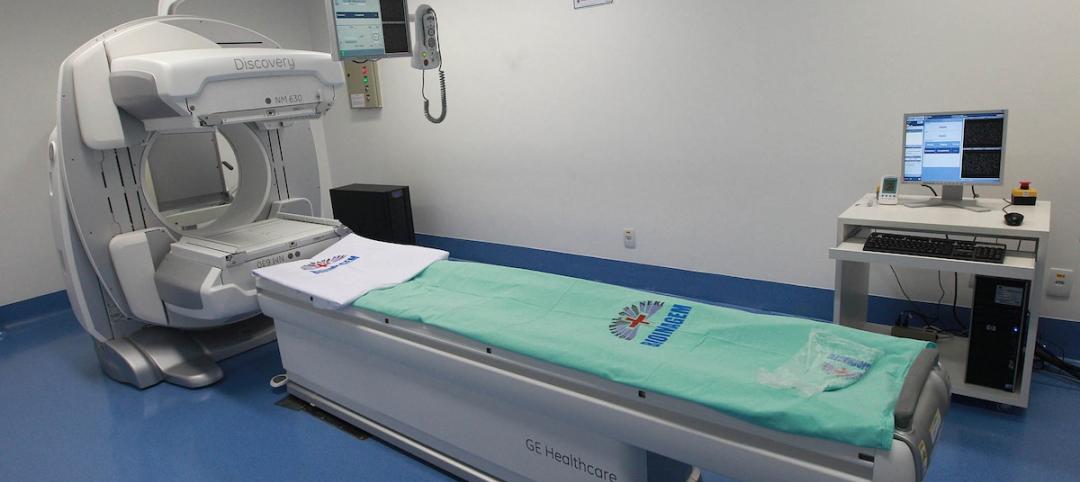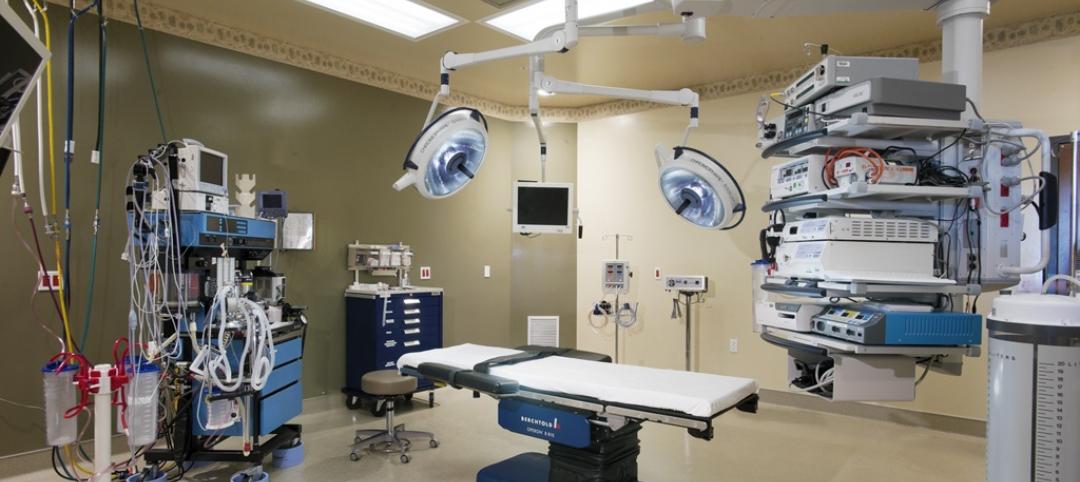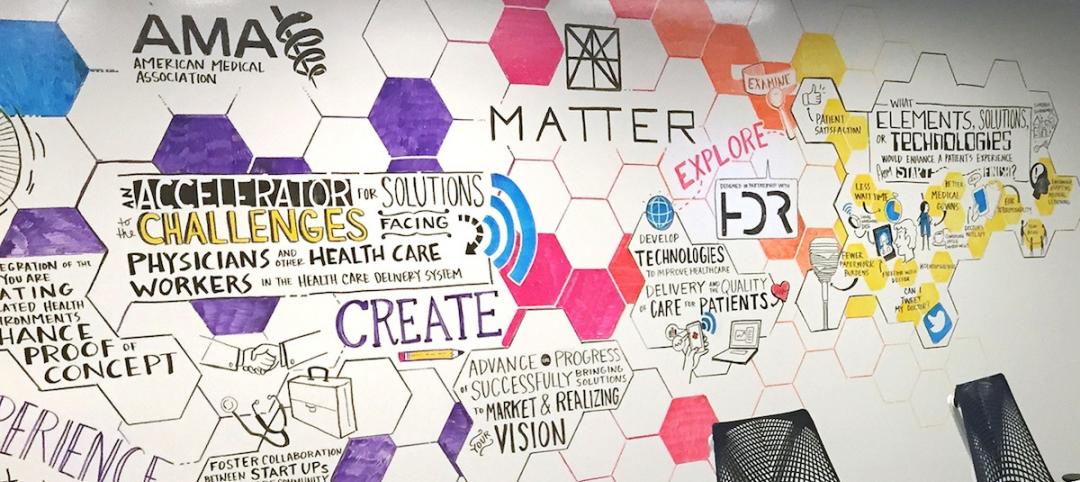The American Institute of Architects (AIA) Academy of Architecture for Health (AAH) has selected the recipients of the AIA Healthcare Design Awards program. The award program showcases the best healthcare building design and healthcare design-oriented research. Projects exhibit conceptual strengths that solve aesthetic, civic, urban, and social concerns as well as the requisite functional and sustainability concerns of a hospital.
Recipients were selected in four different categories:
Category A - Built: Less than $25 million (construction cost)
Category B - Built: More than $25 million (construction cost)
Category C - Renovations/Remodeled: Primarily built within existing hospital or clinical space
Category D - Unbuilt: must be commissioned for compensation by a client with the authority and intention to build
Category A
Harvey Pediatric Clinic; Rogers, Arkansas
Marlon Blackwell Architects
 Photo: Timothy Hursley.
Photo: Timothy Hursley.
Situated in a fast-developing area, the Harvey Pediatric Clinic is an abstract figure set in contrast to the excess of materials, weak forms, and beige tones that make up the everyday suburban landscape that surrounds the building. The cayenne-color metal panel wraps the entire south side of the building, providing a strong identity for the practice. Patients enter the building, pass through and ascend a stair that is washed in blue light from the skylight above. Sixteen exam rooms are organized along a simple, clear circulation path defined by several skylights that bring natural light deep into the building.
Neighborcare Health, Meridian Center for Health; Seattle
NBBJ
 Photo: NBBJ/Sean Airhart.
Photo: NBBJ/Sean Airhart.
Partially funded by a federal grant, the Meridian Center for Health is a first of its kind: an integrated, one-stop model for health treatment and prevention for underserved Seattle-area residents. Uniting three health organizations under the same roof, the center provides low- to no-cost medical, dental, and mental health services for adults and children. Design elements include an open floor plan, a dramatic feature stair in the lobby, and a range of team and community spaces that remain available for neighborhood organizations after hours. The Center is tracking to receive LEED Gold certification.
Category B
Mercy Virtual Care Center; Chesterfield, Missouri
FORUM STUDIO
 Photo: Sam Fentress.
Photo: Sam Fentress.
The Virtual Care Center exemplifies this Catholic health system’s bold commitment to the future of healthcare. This first-of-its-kind facility advances Mercy’s mission of transformative care while dramatically improving outcomes through improved patient management. The design blends the built with nature through an authentic use of materials and space. A palette of stone, glass, precast and wood coupled with flexible floor plates create an environment that fosters innovation, collaboration and patient centric care. The Virtual Care Center, the genesis of a national consortium of virtual providers, pioneers a new model of care.
UC San Diego Jacobs Medical Center; La Jolla, California
Cannon Design
 Photo: Christopher Barrett.
Photo: Christopher Barrett.
Reflective of UC San Diego’s vision toward the future intersections between technology and medicine, Jacobs Medical Center is designed as three hospitals in one with focus on women’s and children’s, cancer and specialty surgery. The tower is the cornerstone of a new campus identity focused on the future of health, pairing cutting-edge, modern medicine with best-in-class patient experience.
Category C
Advocate Lutheran General Hospital Cardiac Catheterization Suite; Park Ridge, Illinois
Philips Design and Anderson Mikos Architects
 Photo: Craig Dugan Photography
Photo: Craig Dugan Photography
The design team worked closely with key stakeholders to achieve Advocate Health Care Heart Institute’s goal of improved customer experience, safety, and outcomes. The new cardiac catheterization suite improves the way people receive care through the complete transformation of patient, family and staff experiences. The resulting optimized flow and journey includes a transradial recovery lounge, labs that inspire confidence while improving safety, and a first-of-its-kind prep/recovery bay solution that enables a less stressful recuperation personalized for each patient. The Advocate Experience has been redefined through the service and spatial design transformation for this Suite.
Bayshore Dental; Whitefish Bay, Wisconsin
Johnsen Schmaling Architects
 Photo: John J. Macaulay.
Photo: John J. Macaulay.
This project is the ambitious reinvention of an abandoned building and its transformation into a state-of-the-art clinic for a young dentist and her small staff. The project’s rigorous architecture and meticulous details echo the ethos of the flawless efficiency, uncompromising precision and exacting purity at the center of the innovative dentistry performed here. Procedural flow strategies informed the clinic’s overall layout. A continuous ceiling plane leads patients from the light-filled reception to the individual operatories, each marked by green vertical panels and light strips that animate the clinic’s central corridor. White oak cabinetry and green accents complement the intentionally restrained interior palette, all contributing to a deliberately serene ambience intended to appease a sometimes-apprehensive clientele.
Category D
Ambulatory Surgical Facility; Kyabirwa, Uganda
Kliment Halsband Architects
 Rendering: Kliment Halsband Architects.
Rendering: Kliment Halsband Architects.
This independent, off-the-grid ambulatory surgical facility is a replicable prototype for the five billion people in the world who lack access to safe or affordable surgery. The building is composed of three functional elements: a reception pavilion with offices grouped around a family waiting area courtyard, an intermediate pavilion for pre-op and post-op activities, and a sterile pavilion with two operating rooms and related support spaces. These elements are sheltered under a solar panel shade structure, inspired by the banana plants on the site.
Related Stories
Healthcare Facilities | Apr 8, 2015
Designing for behavioral health: Balancing privacy and safety
Gensler's Jamie Huffcut discusses mental health in the U.S. and how design can affect behavioral health.
Building Team Awards | Apr 5, 2015
‘Project first’ philosophy shows team’s commitment to a true IPD on the San Carlos Center
Skanska and NBBJ join forces with Sutter Health on a medical center project where all three parties share the risk.
Healthcare Facilities | Mar 31, 2015
BIM and the changing procurement model for medical equipment in healthcare construction
BIM coordination has dramatically reduced change orders during the construction period. Unfortunately, it has had the opposite effect on medical technology integration, writes CBRE Healthcare's Julie Ford.
Healthcare Facilities | Mar 28, 2015
VA construction program ‘a disaster,’ says congressman
The VA construction program took more hits recently after the chairman of a congressional Committee on Veterans’ Affairs called an Aurora, Colo., hospital project “a disaster,” and a key VA official resigned abruptly.
Healthcare Facilities | Mar 23, 2015
Can advanced elevator technology take vertical hospitals to the next level?
VOA's Douglas King recalls the Odyssey project and ponders vertical transportation in high-rise healthcare design.
Healthcare Facilities | Mar 22, 2015
New Joplin, Mo., hospital built to tornado-resistant standards
The new hospital features a window and frame system that can protect patients from winds of up to 250 mph.
Healthcare Facilities | Mar 19, 2015
Grumman/Butkus Associates releases 2014 hospital energy and water benchmarking survey results
The survey results show that hospitals’ overall fossil fuel use has trended downward, but electricity use isn’t declining much.
Healthcare Facilities | Mar 18, 2015
Healthcare design partnership asks: What about the doctor?
HDR's Abbie Clary discusses the design of healthcare facilities and how they affect doctors.
Healthcare Facilities | Mar 16, 2015
Healthcare planning in a post-ACA world: 3 strategies for success
Healthcare providers are seeking direction on how to plan for a value-based world while still very much operating in a volume-based market. CBRE Healthcare's Curtis Skolnick offers helpful strategies.
Retail Centers | Mar 10, 2015
Retrofit projects give dying malls new purpose
Approximately one-third of the country’s 1,200 enclosed malls are dead or dying. The good news is that a sizable portion of that building stock is being repurposed.

















